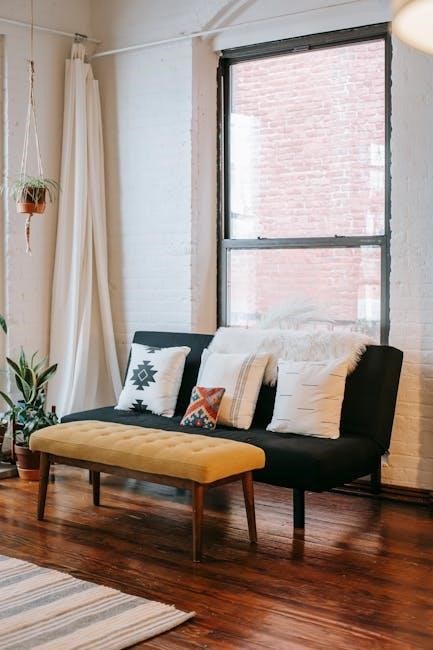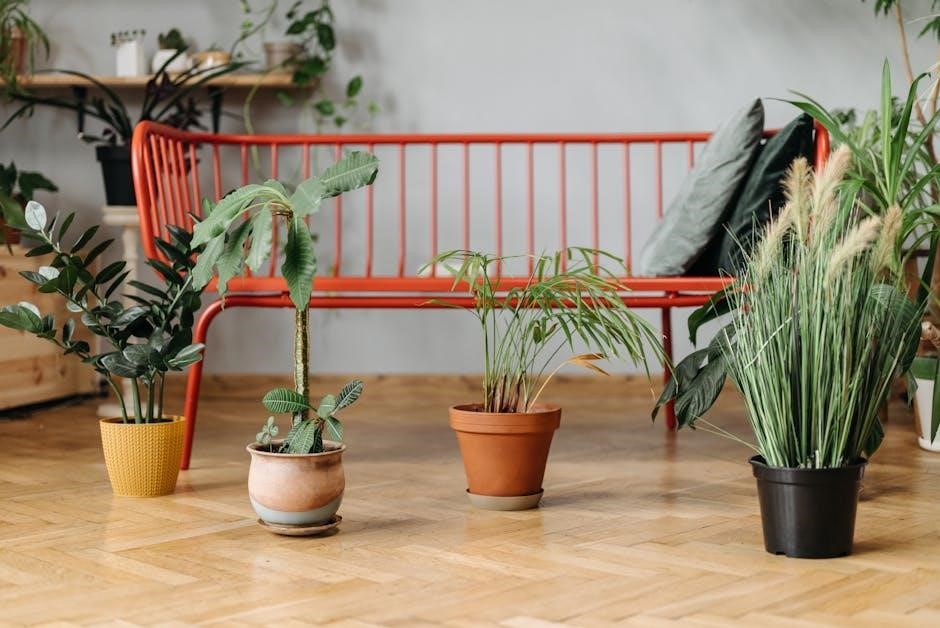
Discover the convenience of potting bench plans in PDF format‚ offering detailed diagrams‚ step-by-step instructions‚ and material lists to help you build a functional gardening workstation efficiently.
Overview of Potting Bench Plans
Potting bench plans in PDF format provide comprehensive guides for constructing a functional and organized gardening workstation. These plans typically include detailed diagrams‚ step-by-step instructions‚ and material lists to ensure a smooth building process. Many designs offer versatility‚ with options for adjustable shelves‚ pegboards‚ and customizable sizes to fit various spaces and styles. Both free and paid plans are widely available‚ catering to different skill levels and preferences. Whether you prefer a simple‚ rustic design or a more complex setup with additional storage‚ potting bench plans in PDF format offer a practical solution for gardeners seeking to enhance their workspace efficiency and organization;
Why Use a Potting Bench?
A potting bench offers a dedicated workspace for gardening tasks‚ enhancing efficiency and organization. It provides a sturdy surface for potting plants‚ storing tools‚ and keeping supplies within easy reach. With built-in shelves and storage solutions‚ a potting bench helps reduce clutter and saves time by keeping everything you need in one place. It also elevates your work‚ reducing strain on your back during extended gardening sessions. Whether you’re a seasoned gardener or a beginner‚ a potting bench is an essential tool that makes gardening more enjoyable and convenient. Its durability and versatility make it a worthwhile addition to any garden or shed.

- Enhances efficiency and organization.
- Provides a sturdy workspace for potting and storage.
- Reduces clutter and saves time.
- Elevates your work to reduce physical strain.
- A versatile and durable gardening essential.
Benefits of Downloadable PDF Plans
Downloadable PDF plans for potting benches offer unmatched convenience and clarity. They provide detailed diagrams‚ step-by-step instructions‚ and material lists‚ ensuring a smooth construction process. PDFs are easily accessible and printable‚ allowing you to refer to them anytime during your project. Many plans are free or affordable‚ making them a cost-effective solution for gardeners. They often include customizable options‚ enabling you to tailor the design to your needs. With a PDF‚ you can avoid guesswork and ensure accuracy‚ making your potting bench both functional and durable. This format is ideal for beginners and experienced builders alike‚ offering a comprehensive guide to creating a practical gardening workstation.
- Detailed diagrams and step-by-step instructions.
- Easily printable and accessible anytime.
- Cost-effective‚ with many free options.
- Customizable designs to suit your needs.
- Reduces guesswork for accurate construction.

Materials and Tools Required
Lumber like 2x4s and 2x6s‚ plywood‚ and exterior screws are essential. Tools include a saw‚ drill‚ screwdriver‚ sandpaper‚ and exterior paint for finishing. A tape measure ensures accurate cuts.
Essential Lumber and Hardware
The lumber required typically includes 2x4s and 2x6s for the frame‚ plywood or planks for the work surface‚ and 1x4s for additional supports. Exterior-grade screws‚ hinges‚ and latches are necessary for assembly and functionality. For added durability‚ consider using weather-resistant wood like cedar or treated pine. Pegboard and hooks can be included for tool organization. Ensure all hardware is galvanized or rust-resistant to withstand outdoor conditions. Measure and cut materials according to the plan’s specifications for a precise fit. Sand all pieces before assembly to ensure smooth surfaces. Proper material selection ensures your potting bench is sturdy‚ functional‚ and long-lasting‚ even in harsh weather conditions.
Tools Needed for Construction
To build a potting bench‚ essential tools include a handsaw or jigsaw for cutting lumber‚ a drill for screwing pieces together‚ and a sander for smoothing surfaces. A tape measure and square ensure accurate cuts and alignment. For precise angled cuts‚ a miter saw or table saw can be useful. Clamps help hold pieces steady during assembly. Additionally‚ a level ensures the bench is even‚ and a wrench or socket set may be needed for hardware like hinges. Safety gear‚ such as gloves and safety glasses‚ is crucial. While some tools are optional‚ these basics will help you construct a sturdy and functional potting bench efficiently. Proper tool preparation ensures a smooth and successful building process.
Recommended Materials for Durability
For a durable potting bench‚ use weather-resistant materials like cedar‚ teak‚ or pressure-treated lumber. These woods withstand moisture and outdoor conditions effectively. Consider using 2x4s or 2x6s for the frame and legs to ensure stability. Plywood or planks work well for the work surface‚ while 1x4s can be used for shelves or back panels. Metal or galvanized hardware‚ such as screws and hinges‚ adds strength and resists rust. Applying a waterproof sealant or exterior paint protects the wood from rot and fading. For added durability‚ incorporate features like pegboards for tool organization or storage bins for supplies. These materials and finishes ensure your potting bench remains functional and attractive for years.

Step-by-Step Instructions
Follow clear‚ easy-to-understand guides with detailed diagrams and photos to build your potting bench efficiently‚ suitable for all skill levels‚ from beginners to experienced DIYers.
Preparing the Materials and Cut List
Start by gathering all necessary materials‚ such as lumber‚ screws‚ and hardware‚ ensuring they match the specifications in your PDF plans. Create a detailed cut list to organize the required lengths and quantities of each board. Use a saw to cut the lumber according to the measurements provided‚ sanding the edges for smoothness. Double-check the cut pieces to ensure accuracy and label them for easy identification. Organize the components in a logical order to streamline the assembly process. Proper preparation of materials and a clear cut list are essential for a seamless and efficient build‚ minimizing errors and saving time. This step sets the foundation for a successful project‚ so attention to detail is crucial.

Assembling the Frame and Shelves
Begin by assembling the frame using screws to attach the legs and side supports. Ensure the corners are square and secure. Next‚ attach the shelves to the frame using pre-drilled holes and screws. Use clamps to hold the shelves in place while drilling to maintain alignment. Start with the bottom shelf for storage and add the top shelf for additional workspace. For stability‚ check that the frame is level and evenly balanced. Consider adding brackets for extra support‚ especially for heavier loads. Once the frame and shelves are assembled‚ proceed to attach the work surface and any additional features. This step requires precision to ensure the structure is sturdy and functional‚ setting a solid foundation for the rest of the project.
Adding the Work Surface and Back Panel
Attach the work surface to the assembled frame using screws‚ ensuring it is evenly spaced and securely fastened. Measure and cut the surface material‚ such as plywood or planks‚ to fit the frame dimensions. Sand the edges for a smooth finish. Install the back panel by attaching vertical slats or a solid board to the rear of the frame‚ providing additional structural support and a place to mount hooks or a pegboard. Use clamps to hold the panels in place while drilling pilot holes to prevent splitting. Ensure the work surface is level and the back panel is aligned properly. Secure all components tightly for a sturdy and durable finish. This step completes the core structure‚ ready for final touches and accessories.
Installing Storage Solutions
Enhance your potting bench’s functionality by installing storage solutions such as shelves‚ pegboards‚ or cabinets. Start by measuring and cutting additional lumber for shelves‚ ensuring they fit securely into pre-drilled slots or brackets. Attach them using screws or brackets for stability. For pegboards‚ mount them to the back panel or side using pegboard hooks or screws. Add bins‚ baskets‚ or small containers to store seeds‚ tools‚ and supplies. Optionally‚ install a drawer or cabinet below the work surface for larger items like potting soil or fertilizers. Secure all storage components tightly to prevent shifting. These additions will keep your gardening essentials organized and within easy reach‚ making your potting bench a practical and efficient workspace.

Finishing Touches and Final Assembly
Complete your potting bench by adding the final touches. Sand all surfaces to ensure smooth edges and splinter-free wood. Apply paint‚ stain‚ or sealant to protect the wood and enhance its appearance. Allow the finish to dry completely before proceeding. Install any additional features like shelves‚ hooks‚ or a pegboard for extra storage. Attach the work surface securely‚ ensuring it is level and sturdy. Double-check all joints and screws for tightness. Finally‚ place the bench in your desired location and organize your gardening tools and supplies. Your potting bench is now ready to use‚ providing a convenient and organized workspace for all your gardening needs.

Design Options and Customization
Explore various potting bench designs‚ from simple to complex‚ and customize size‚ style‚ and features to suit your gardening needs and personal preferences.
Simple vs. Complex Designs
Choose between simple and complex potting bench designs based on your skill level and needs. Simple designs focus on basic functionality‚ requiring minimal materials and tools‚ while complex designs offer advanced features like adjustable shelves‚ storage compartments‚ and intricate details. PDF plans often include both options‚ allowing you to select a design that matches your expertise and desired outcome. For beginners‚ simple designs are ideal‚ as they provide a straightforward building process with clear instructions. Complex designs‚ on the other hand‚ cater to experienced DIYers seeking a customized and multifunctional workstation. Many plans also offer tips for adapting designs to suit personal preferences‚ ensuring your potting bench is both functional and visually appealing.
Adding Shelves and Pegboards
Add functionality to your potting bench by incorporating shelves and pegboards‚ as detailed in many PDF plans. Shelves provide ample storage for pots‚ soil‚ and gardening tools‚ while pegboards allow for hanging items like gloves‚ watering cans‚ and small equipment. These additions enhance organization and accessibility‚ making your workspace more efficient. PDF plans often include measurements and diagrams for installing shelves at various heights and attaching pegboards securely. You can customize the number and placement of these features to suit your specific needs‚ ensuring your potting bench is both practical and personalized. This versatility makes shelves and pegboards essential components for creating a well-organized and functional gardening workstation.
Customizing the Size and Style
Customizing the size and style of your potting bench allows you to tailor it to your specific needs and garden aesthetic. Many PDF plans offer adaptable designs‚ enabling you to adjust dimensions to fit your space or preferences. Whether you prefer a compact bench for small gardens or a larger one with extra storage‚ the flexibility of these plans lets you modify the design accordingly. Additionally‚ you can personalize the style by choosing materials like cedar‚ pine‚ or reclaimed wood‚ and adding finishes such as paint‚ stain‚ or sealants. Some plans also include options for adding wheels or cabinets‚ further enhancing functionality and visual appeal. This customization ensures your potting bench is both practical and uniquely suited to your gardening style.

Downloading and Using PDF Plans
Access detailed potting bench plans in PDF format‚ featuring step-by-step instructions‚ material lists‚ and diagrams for easy construction of your ideal gardening workstation.
How to Access Free and Paid Plans
Free and paid potting bench plans are widely available online‚ offering varying levels of detail and customization. Websites like Ana White‚ Fine Gardening‚ and Epic Gardening provide free downloadable PDFs with basic designs‚ material lists‚ and step-by-step instructions. For more complex or specialized designs‚ paid plans are available‚ often including detailed diagrams‚ customizable options‚ and premium features. Many platforms offer both free and paid versions‚ allowing users to choose based on their skill level and project requirements. Simply search for “potting bench plans PDF” to explore options‚ download the desired plan‚ and start building your ideal gardening workstation with ease.
Understanding the Diagrams and Measurements
Potting bench plans in PDF format typically include detailed diagrams and precise measurements to guide you through the construction process. These diagrams often feature exploded views‚ showing how each component fits together‚ while measurements are clearly labeled to ensure accuracy. Understanding these visuals is crucial for assembling the bench correctly‚ especially for those new to woodworking. Pay close attention to notations for cuts‚ assembly points‚ and hardware placement. Reviewing the plans thoroughly before starting ensures that all pieces align properly. Double-checking measurements against your materials helps avoid errors. By carefully following the diagrams and measurements‚ you can build a sturdy and functional potting bench tailored to your gardening needs.
Following the Instructions Carefully
Adhering to the instructions in your potting bench PDF plans is essential for a successful build. Each step is designed to guide you through the process efficiently and safely. Skipping or misinterpreting steps can lead to structural issues or safety hazards. Before starting‚ thoroughly review the entire plan to understand the sequence of tasks. Gather all materials and tools beforehand to avoid mid-project delays. Pay attention to specific measurements and techniques‚ as they ensure the bench’s stability and functionality. Double-check each cut and assembly to maintain accuracy. By following the instructions diligently‚ you’ll achieve a sturdy‚ well-designed potting bench that enhances your gardening experience. This careful approach guarantees a professional-quality result‚ even for those new to DIY projects.

Tips for Building a Potting Bench
Choose durable‚ weather-resistant wood for outdoor use. Apply waterproof sealants to protect the bench from moisture. Ensure the work surface is at a comfortable height for ergonomic gardening. Add shelves or bins for storage solutions to keep tools organized and within reach. Regularly maintain the bench to extend its lifespan and functionality.
Choosing the Right Location

Selecting the right location for your potting bench is crucial for functionality and convenience. Place it near a water source to simplify watering plants and mixing soil. Ensure it’s under a shaded area or canopy to protect you from direct sunlight while working. Position the bench close to your garden or shed to minimize trips carrying plants and supplies. Choose a level surface to ensure stability and prevent wobbling. Consider accessibility year-round‚ especially if you garden in multiple seasons. Finally‚ ensure the area is well-ventilated to prevent moisture buildup‚ which can damage the bench or promote mold growth. A thoughtfully chosen location will enhance your gardening experience and make your potting bench a practical addition to your outdoor space.
Ensuring Stability and Leveling
Stability and leveling are essential for a functional potting bench. Start by placing the bench on a firm‚ even surface‚ such as a concrete slab or compacted gravel. Use a spirit level to ensure the work surface is perfectly horizontal. If necessary‚ add shims or wooden wedges under the legs to achieve balance. For added stability‚ secure the bench to the ground using anchor screws or weighted feet. Consider using adjustable legs or wheels with locking mechanisms to maintain level positioning on uneven terrain. A stable bench prevents wobbling‚ protecting your tools and plants from accidental spills. Proper leveling also ensures water drains correctly‚ reducing the risk of moisture damage. Prioritizing stability will extend the lifespan of your potting bench and enhance your overall gardening experience.
Maintaining and Upgrading Your Bench
Maintaining your potting bench ensures it remains functional and durable over time. Regularly clean the surface and storage areas to prevent dirt buildup. Apply a weather-resistant finish or sealant to protect the wood from moisture and UV damage. Store small tools and supplies in organized compartments to keep the workspace clutter-free. For upgrades‚ consider adding hooks‚ bins‚ or a removable tray for extra storage. Refer to your potting bench plans PDF for modification ideas‚ such as installing a lid or expanding shelves. Seasonal inspections can help identify wear and tear‚ allowing for timely repairs. Upgrading hardware or adjusting the design ensures your bench adapts to your evolving gardening needs‚ keeping it efficient and enjoyable for years to come.
Building a potting bench using downloadable PDF plans is a rewarding project that enhances your gardening experience. With clear instructions and customizable designs‚ you can create a functional and stylish workstation tailored to your needs‚ ensuring efficient gardening and organization. The satisfaction of crafting your own bench will inspire confidence in your DIY skills and provide years of reliable service. Start your project today and enjoy the benefits of a well-organized gardening space!
Final Thoughts on Building a Potting Bench
Building a potting bench is a fulfilling DIY project that offers lasting benefits for gardeners of all skill levels. With downloadable PDF plans‚ you gain access to detailed instructions‚ material lists‚ and customizable designs‚ making the process straightforward and enjoyable. A well-crafted potting bench provides a dedicated workspace‚ enhancing efficiency and organization in your garden. It also serves as a practical storage solution for tools and supplies. The sense of accomplishment from creating something functional and beautiful is rewarding. Whether you choose a simple or complex design‚ a potting bench will become an indispensable asset in your gardening routine‚ encouraging creativity and productivity for years to come.
Encouragement to Start Your Project
Starting your potting bench project is an exciting step toward enhancing your gardening experience. With readily available PDF plans‚ you can confidently begin building a functional and stylish workstation tailored to your needs. The clear instructions and detailed diagrams ensure that even beginners can achieve professional results. Remember‚ this project is a great opportunity to personalize your garden setup and add a touch of handmade charm. Don’t hesitate to get creative and make adjustments to suit your style or space. Building a potting bench is not only practical but also rewarding‚ offering a sense of accomplishment and a beautiful addition to your garden. Dive in‚ and enjoy the process of creating something truly useful and lasting!